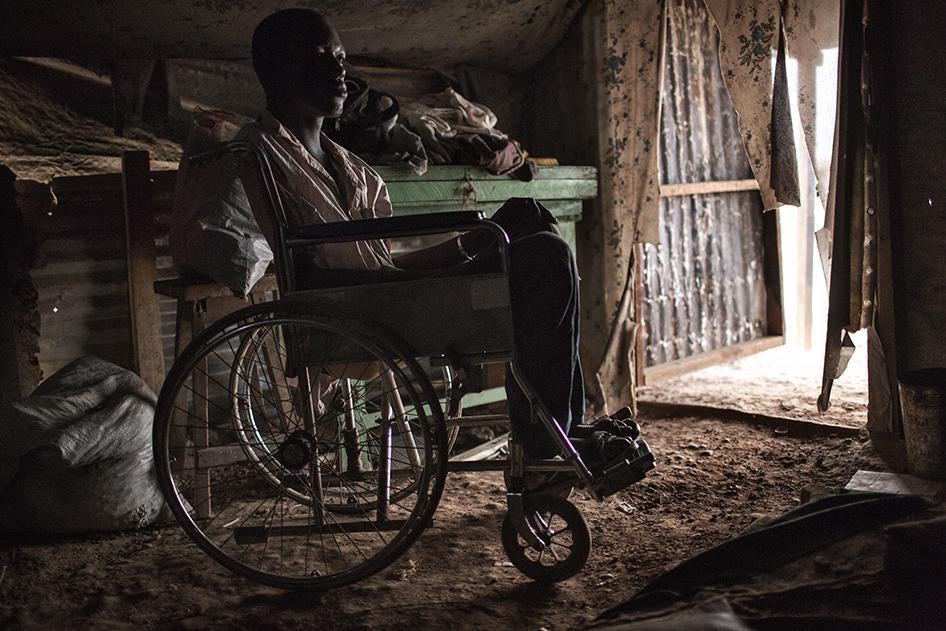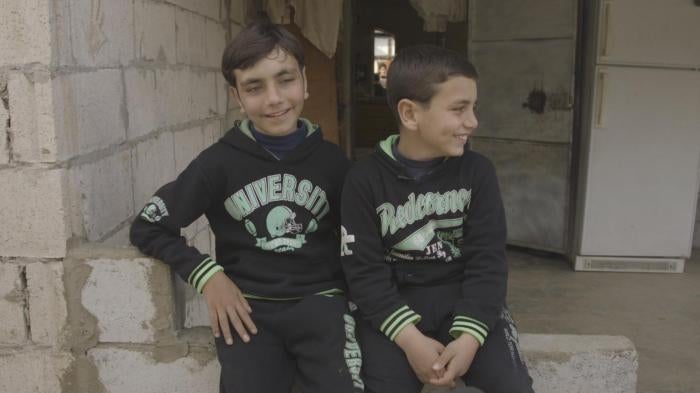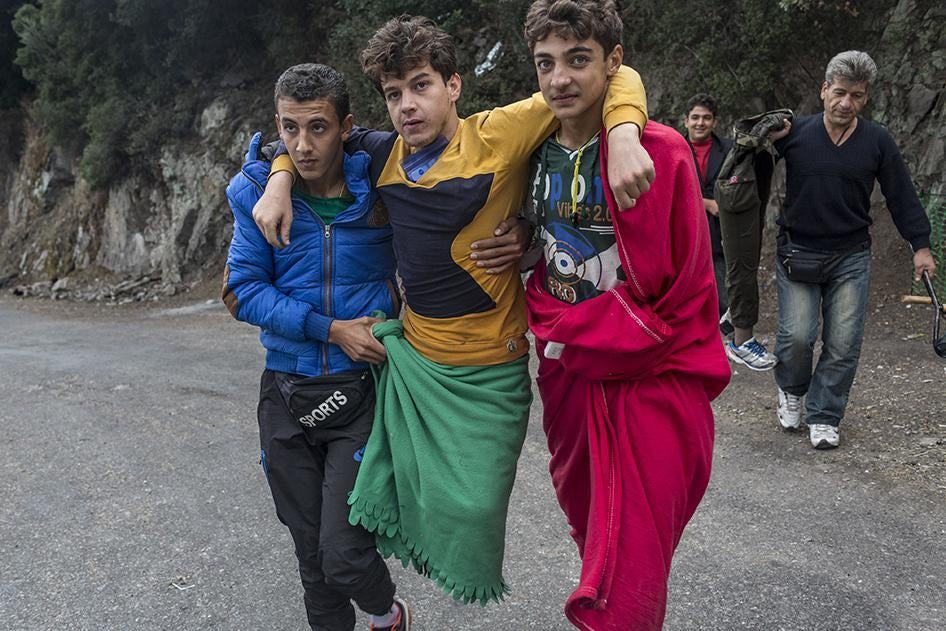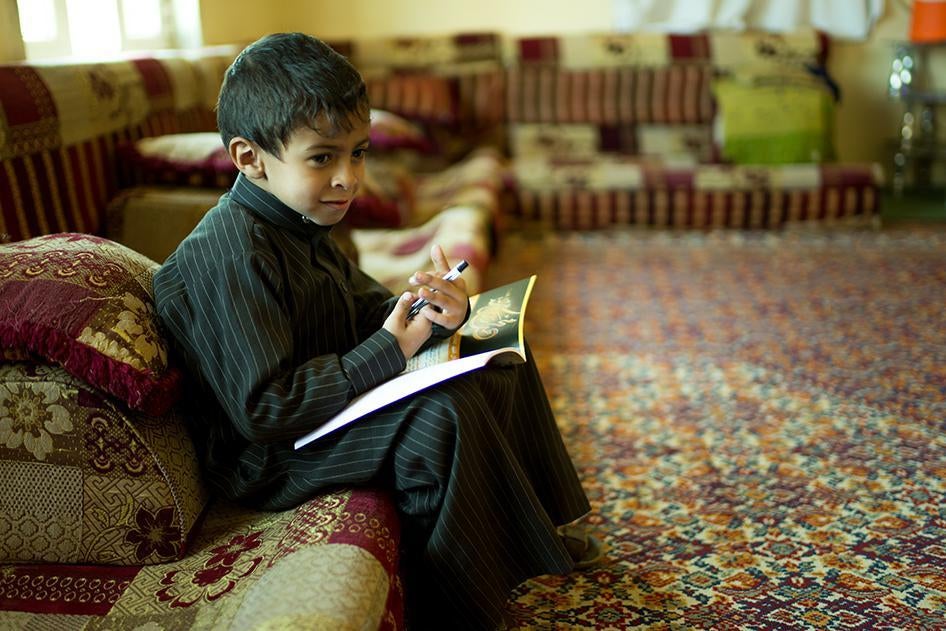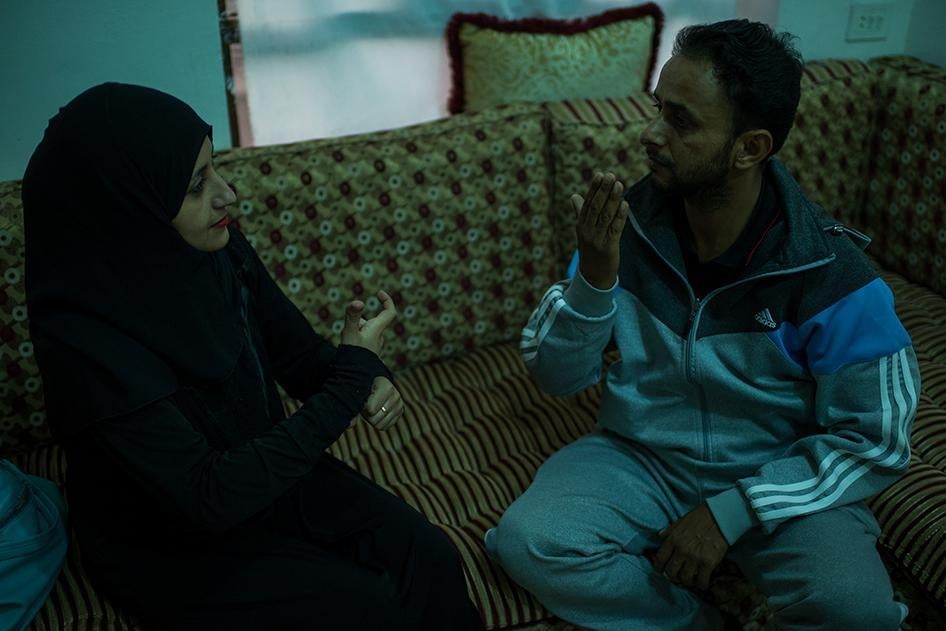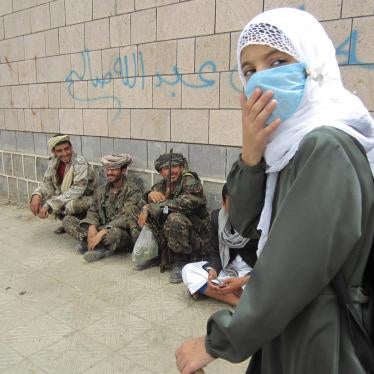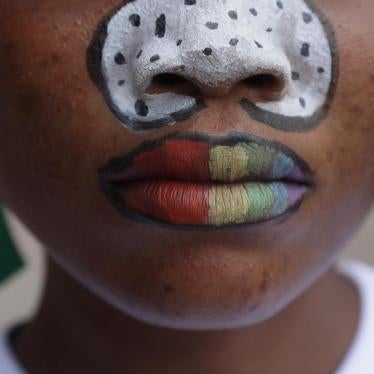The Seleka [an armed rebel group] came and started killing people. I was fast asleep when I heard gunshots and woke up to find myself alone at home. My parents had fled without me. I started shouting and crawled to the entrance of my house but when I looked outside, there was no one. I stayed alone for a day until a young boy passed by. I started crying when I saw him and begged him; “Please help me! If you leave me, I will die.” The young boy feared for me and agreed to carry me on his back until [we got to] the airport [the camp for displaced people].
-Andet, a 27-year-old man with a physical disability, Bangui, Central African Republic, April 2015
Summary
With numerous armed conflicts around the world, it is critical for the global community to reaffirm its commitment to leaving no one behind in humanitarian response, including persons with disabilities.
More than one billion persons worldwide, or about 15 percent of the global population, have a disability.[1] According to the Women’s Refugee Commission, an estimated 6.7 million persons with disabilities are forcibly displaced as a result of persecution and other human rights violations, conflict, and generalized violence.[2]
Between September 2013 and March 2016, Human Rights Watch interviewed more than 100 persons with disabilities and their families, and assessed their needs during the conflicts in the Central African Republic, Iraq, and Yemen. We also examined the particular challenges facing refugees with disabilities in Europe and access to education for Syrian children with disabilities in Lebanon and Jordan.
Human Rights Watch documented that in situations of risk such as armed conflict and humanitarian emergencies, persons with disabilities risked being abandoned in their homes or in deserted villages for days or weeks, with little access to food or water. Persons with disabilities who reached sites for internally displaced people or refugees often faced difficulties accessing food, sanitation, and medical assistance. Children with disabilities either were unable to attend school or did not have equal access to education as other children.
Human Rights Watch urges governments, United Nations agencies, humanitarian organizations, and donors to address the rights and needs of persons with disabilities as a priority in conflict and displacement situations and to develop a more effective, non-discriminatory, and inclusive humanitarian response.
Recommendations
Governments, United Nations agencies, donors and humanitarian organizations should act to ensure the protection, security, and dignity of persons with disabilities in situations of risk, including armed conflict, humanitarian emergencies, and natural disasters, by:
Non-discrimination
- Providing persons with disabilities access to humanitarian response, both in terms of protection and assistance, on an equal basis with others, and allowing them to fully enjoy their rights.
- Endorsing the Charter on Inclusion of Persons with Disabilities in Humanitarian Action and its Action Plan, presented at the May 2016 World Humanitarian Summit in Istanbul, Turkey.
Participation
- Promoting meaningful involvement of persons with disabilities and their representative organizations in the design, implementation, monitoring, and evaluation of preparedness and response programs and drawing from their leadership, skills, experience, and other capabilities by ensuring their active participation in decision-making and planning processes including in appropriate coordination mechanisms.
- Providing appropriate financial and other support so that the rights and needs of persons with different types of disabilities are addressed in humanitarian efforts.
- Appointing persons with different types of disabilities to camp management committees to better ensure that their concerns are represented and acted upon.
Inclusive policy
- Developing and implementing policies and guidelines on disability inclusion in humanitarian response. Such guidelines should address coordination, cooperation, implementation, monitoring, and financing, and further support humanitarian actors’ inclusive practices.
- Collecting data disaggregated by age, gender and disability, and analyzing such data so that the rights and needs of persons with disabilities are addressed in humanitarian response. The confidentiality and privacy of persons with disabilities should be respected in data collection processes.
Inclusive response and services
- Providing separate access or adopting other measures to overcome obstacles to access to humanitarian assistance to persons with disabilities.
- Providing adequate, appropriate, and rights-respecting medical care, including mental health care, counseling, and psychosocial support to persons with disabilities.
- Enhancing accessibility to medical facilities, including through provision of access to a sign language interpreter or an appropriate support person.
- Facilitating access to education for children with different types of disabilities by training teachers and making classrooms fully accessible.
- Acting to ensure the physical environment in displacement camps, including basic necessities, housing, schools, and medical facilities are accessible to persons with disabilities and that the architecture and layout of camps responds to the needs of persons with disabilities. This can be facilitated by including persons with different types of disabilities in camp planning and evacuation plans.
- Providing persons with disabilities equal access to information about camp services such as medical care, food distribution and evacuation plans, through easy-to-understand materials or other relevant communication methods.
Cooperation and coordination
- Sensitizing all international and national humanitarian staff, and local and national authorities on the rights, protection, and safety of persons with disabilities and further strengthen their capacity and skills to identify and include persons with disabilities in humanitarian preparedness and response mechanisms.
- Requesting UN peacekeeping mission staff, together with persons with disabilities and human rights experts, to develop and implement action plans addressing how persons with disabilities will be included, supported, and protected by peacekeeping activities.
- Urging that each peacekeeping mission has adequate disability expertise on staff and that peacekeeping programs are sensitive to the concerns of persons with disabilities.
Abandonment and Obstacles in Fleeing
When attacks occur, families of persons with disabilities are faced with a difficult choice; either assist their relative at the risk of being killed, or flee without them and save themselves. As a result, persons with disabilities are often left behind.[3]
Human Rights Watch documented the obstacles of flight and abandonment in the Central African Republic, Iraq, and the refugee crisis in Europe.
Central African Republic
In the Central African Republic, Human Rights Watch found that in the wake of attacks on communities by armed groups starting in 2013, at least 96 persons with disabilities had been abandoned or were unable to escape when their homes came under attack, and 11 were killed.[4]
Hamamatou, a 13-year-old polio survivor was carried on her brother’s back following an assault on their village. As her brother grew too tired to continue, Hamamatou begged him to save his own life and leave her. When combatants found her two weeks later, Hamamatou told Human Rights Watch, “The fighters said, ‘We have found an animal. Let’s finish it off.’” Another fighter intervened to save her life.[5]
Some persons with disabilities in Central African Republic spent days or weeks, and in a few cases up to a month, in deserted neighborhoods or villages with little food or water. A key challenge in escaping was the absence of assistive devices such as wheelchairs, tricycles, or crutches, which were lost in the chaos, left behind, or looted. Furthermore, many people with physical or sensory disabilities found the prospect of the journey too daunting and so decided to stay behind. Others chose to stay in their homes believing that, because of their disability, attackers would spare their lives. But in some cases people with disabilities who were unable to flee were killed by the attackers.
Persons with disabilities face further risks in emergency situations due to barriers in receiving information or lack of awareness about the danger they face. For instance, since attacks come without warning, persons who are deaf or have a psychosocial or intellectual disability simply did not hear, know about, or understand what was happening. Human Rights Watch documented the case of a tailor with a psychosocial disability in Bangui who was shot and killed by the rebel group because he continued to work at his shop in the market while everyone else fled. One of his acquaintances said: “He just didn’t understand.”[6]
Iraq
Based on examinations of gravesites around Mount Sinjar in northern Iraq, Human Rights Watch documented cases of children with disabilities who were left behind when family members fled as attacks approached in Iraq.[7] Human Rights was able to access these sites after Kurdish forces recaptured the area from the extremist group Islamic State, also known as ISIS.
Information collected from witnesses and officials involved in exhuming the sites indicates that at least three victims in different sites had disabilities.
ISIS caught and then killed elderly or sick Yezidis or those with disabilities, after they were apparently unable to flee attacks in time, eyewitnesses said.
Refugee Crisis in Europe
Human Rights Watch documented how persons with disabilities and their families also face challenges when journeying from war torn countries like Syria, Iraq, and Afghanistan to Europe.
For example, persons with disabilities told Human Rights Watch that smugglers did not allow them to take their assistive devices, such as wheelchairs, onto small rubber boats when fleeing to seek protection in Europe. Others explained that the difficult terrain made travel with an assistive device unfeasible.[8] Many Syrians, who lost limbs in the relentless bombardment of their country were carried by relatives and friends for long distances, an exhausting experience both for them and for those providing assistance.
Sara, a 13-year-old Syrian traveling with her older sister and mother, has a physical disability and diabetes and uses a wheelchair. She told Human Rights Watch about her harrowing experience on the rubber boat from Turkey, where she was separated from her family members, ended up in the water at the bottom of the dinghy, swallowed salt water, and fell unconscious.[9] Having fled the war in Syria in July 2015 only to be turned away from the German and Swedish embassies in Turkey, the family felt they had no choice but to risk their lives and make the trek to the Greek island of Lesbos.
Access to Food, Sanitation, and Medical Services
Lack of equal access to food, sanitation, and medical services is a serious concern for persons with disabilities in humanitarian emergencies. This is because of various challenges including: the destruction of hospitals and other infrastructure on which persons with disabilities rely, difficulties in physically reaching services, shortages of vital supplies due to limited humanitarian access or demand for treatment of people injured in the conflict, and challenges in accessing registration processes or acquiring legal status as refugees.
Human Rights Watch documented instances of these barriers in Central African Republic, Yemen, Iraq, Europe, and Lebanon.[10]
Refugee Crisis in Europe
In March and April 2016, Human Rights Watch documented how thousands of asylum seekers and migrants, including many persons with disabilities, at the Athens port of Piraeus and on the Greek islands of Lesbos and Chios faced appalling living conditions as the humanitarian crisis for people trapped in Greece due to border closures intensified.[11]
Human Rights Watch found, for instance, that accessing basic necessities such as toilets is particularly difficult for persons with disabilities. Many, including numerous women with disabilities, described to Human Rights Watch the struggle of not being able to wash for days, or even weeks.
Nawael, a 34-year-old Syrian woman in a wheelchair who had been staying in Piraeus with her husband and three children for more than ten days told Human Rights Watch:
Here it is very hard for me to go to the toilet. My husband helps me at the door and random women help me inside the toilet. I don’t sleep at night because my body is itchy. My husband helped me and I washed my hair with cold water, but then I got sick. Ten days ago, I got my period and I swear to God, I still haven’t had a shower. And I [usually] pray, but given that I haven’t had a shower, I can’t pray.[12]
At the VIAL center for refugees, migrants and asylum seekers on Chios, which since the implementation of an agreement between the European Union and Turkey on March 20 has become a detention center, the roughly 1,000 detainees are only allowed to move in a limited area with housing containers, surrounded by a fence with barbed wire. VIAL has no showers that are accessible for people in wheelchairs and only one accessible toilet for people with physical disabilities in each section of the camp.[13]
With informal camps like Piraeus, and those on Lesbos and Chios, growing every day, and overwhelmed volunteers who are de facto in charge of running them, Human Rights Watch found that essential needs of women with young children, single mothers, pregnant women, people with disabilities, or people in need of medical care are not being met.
Human Rights Watch met a 45-year-old woman from Afghanistan on the island of Lesbos, a former professor who fled the Taliban, huddling in the corner of her container. Her nephew said she has severe psychosocial disabilities and showed a document from the Spanish Red Cross indicating she has severe depression and adjustment disorder, which is typically triggered by an intensely stressful event. As recommended treatment, a doctor had suggested a variety of anti-depressants and anti-psychotics, but the nephew said he had not been able to obtain any medications or other mental health care.[14]
Another Afghan woman, mother of 9-year-old and 18-month-old boys, both of whom have epilepsy, told Human Rights Watch that her 9-year-old, who had been having seizures since the boat ride from Turkey, had not had his medicine in a week. She said the smugglers threw the medicine and special food they give him into the sea, threatening to throw the boy in as well when they protested.[15]
In October 2015, Human Rights Watch also documented the situation of a young man, Ayman, 28, who has a physical disability resulting from when a rocket fell on his home in Damascus. He was denied access to a wheelchair while locked up in an immigration detention center in Hungary for crossing the border from Serbia.[16] When Human Rights Watch spoke to him, Ayman had been locked up for more than 40 days. He said his wheelchair had broken at the border, and he spent 23 days lying on a bed until his lawyer was able to get a donated wheelchair for him. “Every two or three days all the others are taken out to the courtyard to get some fresh air, for 15 or 20 minutes,” he said. “I haven’t been out for 42 days because of the stairs. Even animals are treated better. We haven’t done anything wrong, why are we here.”
Syria
In December 2012, some psychiatric hospitals in Aleppo, Syria, were damaged or destroyed under constant shelling, causing staff to flee and leaving patients to fend for themselves. The few psychiatric facilities that remained open, such as Dar al-Ajaza, faced chronic shortages of supplies.[17] The hospital now depends on a few charitable businessmen to keep afloat. “There’s no electricity, no bread, no medications, no doctors," said Abu Abdu, 31, the caretaker. In one room, 12 patients with the most severe mental and psychosocial disabilities shared four beds. Bundled up in blankets, they formed a single mass.[18]
Yemen
For persons with disabilities, the inflated price of medication and fuel and the lack of facilities have serious consequences. From April 2015 to April 2016 the closure of nearly 300 organizations that provided specialty services to persons with disabilities in Yemen further deepens this dearth of support.[19]
For example, Khalid, 15, has Duchenne muscular dystrophy and lives with his family in Sanaa, the capital. Until age 2, Khalid was able to walk with some difficulty, but his condition deteriorated and he is now living with quadriplegia. Since before the war, Khalid and his mother, Safiya, have not received any assistance - such as diapers, a mattress, or physical therapy sessions - from the government or humanitarian organizations operating in Sanaa to address his needs.
Human Rights Watch researchers observed Khalid lying down on the floor on a thin sponge-like mattress where he, according to his mother, spends his entire day.[20] He was enrolled in school until the fourth grade but no longer attends. Khalid does not have a wheelchair to help him move around.
Stress from the war has also impacted Khalid's physical and mental health. When Saudi-led coalition airstrikes started attacking Houthi rebel forces in Sanaa in March 2015, he would panic and refused to eat, drinking only milk. The family had to give him an IV drip because he quickly became malnourished.
Hanan, a 4-year-old girl with cerebral palsy and epilepsy in Yemen, also needs medications that have become unaffordable as the conflict continued. Hanan’s father told Human Rights Watch: “Her medication is important for her health because when she takes it regularly, she only experiences an epileptic seizure once every two weeks. But when she does not take the medicine, she experiences a seizure twice a day…. It’s hard to feel useless.”[21]
Iraq
In January 2016, Human Rights Watch interviewed fifteen women and girls who had escaped ISIS, seven of whom recently lived in the IDP camps in Iraqi Kurdistan’s northwestern Dohuk governorate. The women and girls Human Rights Watch interviewed who were held for longer than a year said they were bought and sold multiple times by different ISIS members. Three of the women had four different owners while in captivity, and were raped by most of them.[22] Only one of the fifteen women and girls interviewed by Human Rights Watch had access to much needed mental health care and psychosocial support while in IDP camps.
According to 11 government and non-governmental mental health care and psychosocial support providers, most Yezidi women who escaped ISIS abduction show signs of post-traumatic stress disorder and mental health conditions.[23] Initially overwhelmed by the needs, the government has provided a survivors’ center, staffed by two psychologists.
Dr. Nezar Ismet Taib, Director General of the Directorate of Health, Duhok Governorate, told Human Rights Watch that the center has registered 668 women and girls, all of whom escaped ISIS. Non-governmental organizations are providing outreach activities into displaced persons’ camps, including some psychosocial activities and in some cases care from psychologists. Referral pathways have been established, which have helped ensure women and girls experiencing acute emotional distress are provided with emergency medical care. At least 60 women in the Kapartu camps, for instance, threatened or attempted to commit suicide between June and August 2015.[24]
However, the quality of services in the camps varies, and women and girls who live in camps further from the city of Dohuk or in non-camp settings receive fewer opportunities for support. A lack of outreach, stigma surrounding mental health conditions and sexual violence, no money for transport to the survivors’ center or other facilities, and a lack of knowledge about, and understanding of, existing services have stopped women and girls from accessing assistance.[25]
Only one of the women and girls with whom Human Rights Watch spoke was receiving medium or long term counseling, although they all reported struggling with problems such as insomnia, flashbacks, anxiety, and depression.[26] “I would definitely go to a psychologist if one was available,” Noreen, 19, told Human Rights Watch.
Central African Republic
Persons with disabilities interviewed by Human Rights Watch in IDP camps in the Central African Republic in January and April 2015 said that they were unable to make their way to food distribution sites because the locations were inaccessible, or that by the time they got to the site with assistance, the distribution was already over.[27] For example, Andet, a 27-year old man who is paralyzed from the waist down, told Human Rights Watch how the food distribution site in the M’Poko camp was inaccessible for him, and people like him would get pushed aside. Sometimes he went without food all day, he said.[28]
Accessing basic necessities such as latrines was also difficult and often people with physical disabilities had to crawl on the ground to enter, exposing them to potential health risks and infections.
Jean, a man with a physical disability whom Human Rights Watch met in the M’Poko camp in January 2015, said: “My tricycle doesn’t fit inside the toilet so I have to get down on all fours and crawl. Initially I had gloves for my hands so I didn’t get any [feces] on them but now I have to use leaves.” As of November 2015, there were 233 people with disabilities living in various displacement sites across the country—110 in the M’Poko camp, 44 at Mt Carmel in Bimbo, and 33 at the Seminiare St. Mark camp, also in Bimbo.[29] Of these, 181 people have been in the camps for over two years, entering in December 2013.
For persons with sensory disabilities, moving around M’Poko camp without assistance can be extremely dangerous. Human Rights Watch documented several cases in which blind persons fell into filthy open sewage drains in the camp, or were burned by open fires or boiling water. The camp clinic has no one to facilitate communication with persons who are deaf.[30] As a result, deaf persons who cannot read or write and are not accompanied by a relative or friend who can assist with communication may hesitate to seek medical help or find it difficult to communicate if they do.
Access to Education
Conflict and displacement are particularly disruptive for children and young people with disabilities who are unable to attend school or receive education in an inclusive manner, or who do not receive necessary psychosocial support for events they saw during conflict. Parties to a conflict often occupy school buildings, turning the schools into military targets subject to attack. Human Rights Watch documented instances of these challenges in Yemen, Central African Republic, Lebanon and Jordan.
Yemen
In Yemen, Houthi rebels unlawfully placed the al-Noor Center for the Blind in Sanaa at grave risk by basing militia forces in the facility’s compound while not taking all feasible precautions to remove civilians from the vicinity. A Saudi Arabia-led coalition bomb that hit the compound on January 5, 2016, did not explode, but injured four civilians and damaged the capital’s only center for people with visual disabilities.[31]
Human Rights Watch visited the three-building school on January 6 and interviewed five witnesses to the airstrike, including three of the wounded.
Saleh al-Matari, 27, a staff member, said:
I saw light and then shards of glass as the window shattered. I heard screaming and crying from the housing building. Moments later I saw crowds of people in the yard of the compound helping to evacuate about 30 blind students from the residence.[32]
The shock damage from the bomb impact broke windows and blew out doors in three buildings in the compound, as well as at least four neighboring buildings. The strike wounded two staff members, an 18-year old student from the center, a local resident and a Houthi guard. Had the bomb detonated, damage to the buildings and civilian casualties could have been far greater.[33]
Central African Republic
In January and April 2015, in the Central African Republic, Human Rights Watch documented that very few children with disabilities are enrolled in schools in IDP camps like M’Poko.[34] When Human Rights Watch visited the school in the M’Poko camp in April 2015, it had over 3,797 children enrolled; of whom only 14 have disabilities. While the school is wheelchair-accessible, the route to the school is not. Children with physical disabilities cannot attend unless a family member takes them there and picks them up, and they have an assistive device. Without an assistive device, such as a wheelchair, children with physical disabilities can find it hard to sit all day on the floor.
The school’s staff told Human Rights Watch that some parents are hesitant to send their children with physical disabilities to the school as they fear that in case of an attack the children will not be able to flee. Children with sensory or intellectual disabilities are unable to attend the school because the school does not have teachers trained in inclusive methods.
“None of our staff is trained to teach children who are blind, deaf, or have other disabilities,” said a staff member working at the school. “So it serves no purpose to let children with disabilities come to this school.”[35] The school staff has encouraged parents to enroll their children, but has not actively sought to enroll children with disabilities.
Jordan
Human Rights Watch research conducted in October 2015 found that some Jordanian schools had accepted Syrian children with physical disabilities, consistent with Jordanian policy on inclusive education. However, some public schools lacked necessary facilities for children with physical disabilities, who also faced difficulty with transportation to and from school. Parents of children with multiple disabilities – usually intellectual and physical – told Human Rights Watch that they either could not enroll their children, or did not attempt to do so because they assumed the school would reject their children.
A 2015 UN and NGO survey found that three percent of Syrian school-age refugee children in Jordan had at least one disability, most commonly physical disabilities or low vision and blindness.[36] The most common reason why Syrian children with disabilities were not in school was because the school was not physically accessible to them.[37]
Hanin and Bayan, sisters who attend the first and fourth grades at a Jordanian public school in Mafraq, have difficulty walking. The school has no elevators or wheelchair ramps, their mother told Human Rights Watch, and although she expressed gratitude to the school staff, she feared they will have to drop out because of the steep cost of transportation and the lack of support to her daughters in school:
The principal let them enroll even though the school is not accessible. And the teachers don’t make them stand in line at assembly – they can go directly to class. Hanin was the second-best in her class and even the principal told me not to take her out of school. But it takes them 30 minutes to get to school, and I have to be with them and help carry them. They’re getting heavier, and their bags are heavy. I can only afford to pay a car one dinar [US$1.4], but the drivers asked for 25 dinars [US$ 35] a month. I don’t want the girls to be at home, and they told me they want to study, so they’ll be able to read, not like me. But Bayan has to go to another floor with the first graders, and there are two big steps. There aren’t any other kids I know of with disabilities in the school. I don’t think they’ll be able to stay there.[38]
Of the five Syrian children who had both physical and intellectual disabilities whose families Human Rights Watch interviewed, four had never attended school in Jordan. Amal, who came to Jordan in 2013 from Homs, said that her 12-year-old son, Ali, had physical and intellectual disabilities and that he was not in school because “there were no schools who will take kids with disabilities like his.”[39]
Hind has seven children, with five under the age of 18. She told Human Rights Watch that her 12-year-old daughter, Nada, who has Down Syndrome, was previously enrolled in a special school for children with Down Syndrome after the family arrived in Jordan in 2012. Hind had to pull Nada out of school in 2014 because she could not afford a bus to the school. She had hoped to enroll Nada instead in a nearby public school where some of her other children were enrolled, with lower bus costs (6 Jordanian dinars per month, or around US$8). However, the school director said there was “no room.” “Now Nada stays at home,” Hind said.[40]
Ahlam, 31, said her 10-year-old son Mohamad was burned on his neck and lost sight in one eye in Syria during a July 2014 accident at a school where 4,000 displaced persons were sheltering. Mohamad has had two surgeries and “always has headaches,” his mother said. His teacher follows up with the family, but the only accommodation he receives at school in light of his impaired vision is that “she lets him sit in the front of the class.”[41]
Many Syrian parents said their children had witnessed traumatizing events in Syria before fleeing to Jordan. In some cases, a lack of mental health care and psychosocial support services led them not to enroll in school in Jordan. For example, 16-year-old Ahmed had already dropped out of school in Syria at age 9 to take care of his father’s small store, but he had wanted to go back to school until experiences during the conflict “changed his personality,” his mother said. “He carried injured fighters and dead bodies, and once he had to carry his cousin’s head. His father was arrested in 2011 and detained for a year and a half. I tried registering him in school [in Jordan] but he didn’t want to. He doesn’t even want to leave the house anymore.”[42] She was not aware of any available mental health services for her son.
Other services were limited, or could not be sustained long-term. Jordan’s health care system provided free physiotherapy for Ali, the 12-year-old whose case is discussed above, at the Princess Basma Hospital in Amman in 2014, “but after a month they called us and said it was all they could do, so treatment ended.”[43] Ali’s mother, Amal, said her family had received one-time cash assistance from Save the Children and a wheelchair and diapers from a local charity, but that she had not been able to afford Ali’s prescribed medication.
Humanitarian organizations have provided hundreds of thousands of refugees in Jordan with some psychosocial support services.[44] However, more support and longer-term community-based assistance to children with mental health conditions are needed, especially for refugee families who have been in Jordan for several years.[45]
Lebanon
Human Rights Watch documented that children with disabilities have been largely excluded from efforts to provide Syrian children access to education, despite a 2014 study by Handicap International which found that approximately 20 percent of Syrian refugees in Lebanon have a disability.[46]
Thirteen humanitarian and disabilities organizations working in Lebanon told Human Rights Watch that little or nothing had been done to ensure that children with disabilities can access education.[47] In discussing the options for children with disabilities, one local expert told Human Rights Watch, “In most cases, public schools are not letting in Syrians with disabilities. Where they enroll, there are no services.”[48] Human Rights Watch spoke with the families of 14 children with disabilities, many of whom have been turned away when trying to enroll their children in Lebanese public schools.
The humanitarian response has taken some steps to improve accessibility, but they are mostly limited to small improvements focused on physical accessibility. For example, as of December 2015, just 7 out of 72 newly rehabilitated schools met physical accessibility standards for children with disabilities.[49]
Maysa, 30, has a 10-year-old daughter, Layla, who has an intellectual disability. She tried to enroll Layla in several public schools and an NGO-run school, all of whom rejected her. “They told me ‘we don’t accept these types of cases’ ….I don’t want anything. I just want her to learn.”[50] Abir, 30, had a similar experience. She has two children, 6 and 10 years old, both of whom have intellectual disabilities. She first tried to enroll her younger child in a private school, but it was “not equipped” to teach him, she said, and staff there told her that she was “wasting my money because he had special needs.” In 2014, she enrolled the children in a special school at a total cost of US$1,650, per year but can no longer afford to do so. Abir has since been unable to enroll them in public or private schools in Lebanon. She told Human Rights Watch, “I tried to enroll my 10-year-old in a public school but they turned him down, even from kindergarten. They told me that other students would make fun of him. So now he’s at home.”[51]
Even where Syrians are able to enroll children with disabilities in Lebanese public schools, it does not mean that schools adequately accommodate the needs of all children to ensure they receive quality education on an equal basis with others. For instance, Kawthar, 33, has a 12-year-old son, Wa’el, with Hunter Syndrome, a developmental disability. While Kawthar was able to enroll Wa’el in public school, the school refused to take even basic steps to provide accommodation, such as allowing him to sit in the front row so that he could concentrate better. “It’s a small request,” Kawthar said. She told us,
He’s having trouble understanding, and without the books I can’t help him keep up. He doesn’t get any special attention, they treat him like any other student. One time he came home crying because other kids were making fun of him. The quality [of education] is awful. I’m trying to teach them at home, but their books still haven’t arrived.[52]
In a follow-up interview in February 2016, Kawthar told Human Rights Watch that she had withdrawn her children from school because they were not learning, and because of the high cost of transportation (about US$80 per month) to keep them in school.[53]
The lack of educational opportunities for children with disabilities in Lebanon is especially frustrating for children who were able to attend school in Syria. Khalid, 29, told Human Rights Watch that his brothers Mo’ayad, 13, and Majed, 18, cannot speak or hear. They reached fifth grade and ninth grade in Syria and were exceptional students. Khaled said: “In 2013, they left for Damascus when Raqqa fell [to armed rebel groups]. The most important thing was education. They would wake up at 5 a.m. to get to school at 8 a.m. because of the checkpoints. It was very expensive.” At that point, Khaled’s parents sent Majed and Mo’ayad to Lebanon, where they have been out of school for three years.
In Lebanon, Khaled tried to enroll his brothers in several centers and schools. He says one school told him that it didn’t accept foreigners, another said it would charge him US$4,000, and a third said it didn’t have the capacity to teach his brothers. Khaled told us,
I would travel anywhere as long as my siblings go to school and get health care…. I’ve lost hope in registering them in any school. I try to take them out of the house, but during the day they stay at home.[54]
The Way Forward
Persons with disabilities face unique challenges during humanitarian emergencies, from abandonment and neglect, to lack of equal access to basic services. While governments, humanitarian organizations, and donors are overwhelmed with many competing priorities during emergencies, they should act to ensure that the needs and concerns of persons with disabilities are addressed in humanitarian efforts. Including persons with disabilities and their representative organizations will bring an important, often untapped, perspective to humanitarian efforts, and benefit the larger affected community.
[1] World Health Organization, “Disability and Health,” December 2015, http://www.who.int/mediacentre/factsheets/fs352/en/ (accessed January 28, 2016).
[2] Women’s Refugee Commission, “Refugees with Disabilities Fact Sheet,” 2014, https://www.womensrefugeecommission.org/disabilities/disabilities-fact-sheet (accessed January 28, 2016).
[3] Human Rights Watch, “Central African Republic: People With Disabilities Left Behind,” April 28, 2015, https://www.hrw.org/news/2015/04/28/central-african-republic-people-disabilities-left-behind.
[4] Ibid.
[5] Ibid.
[6] Ibid.
[7] Human Rights Watch interviews in Iraq with families fleeing ISIS attacks, August 2014. Human Rights Watch, “Iraq: Protect Mass Graves Evidence of Possible ISIS Genocide Endangered,” January 30, 2016, https://www.hrw.org/news/2016/01/30/iraq-protect-mass-graves.
[8] Human Rights Watch, “People with Disabilities at Added Risk in War, Displacement: Ensure Equal Access to Services,” December 3, 2015, https://www.hrw.org/news/2015/12/03/people-disabilities-added-risk-war-displacement.
[9] Ibid.
[10] Human Rights Watch, “Dispatches: Invisible Victims of the Syrian Conflict—People With Disabilities,” September 19, 2013, https://www.hrw.org/news/2013/09/19/dispatches-invisible-victims-syrian-conflict-people-disabilities Human Rights Watch, “Attacks on Health Facilities, Staff, Patients Lack of Monitoring, Protection, Justice Impede Access,” May 20, 2015, https://www.hrw.org/news/2015/05/20/attacks-health-facilities-staff-patients Human Rights Watch, “Yemen: Coalition Airstrikes Hit Hospital Credible, Impartial Inquiry Needed into Attack,” October 27, 2015, https://www.hrw.org/news/2015/10/27/yemen-coalition-airstrikes-hit-hospital Human Rights Watch, “Yemen: Embargo Arms to Saudi Arabia US, UK, France Risk Complicity in Unlawful Airstrikes,” March 22, 2016, https://www.hrw.org/news/2016/03/21/yemen-embargo-arms-saudi-arabia Human Rights Watch, “Central African Republic: People With Disabilities Left Behind,” April 28, 2015, https://www.hrw.org/news/2015/04/28/central-african-republic-people-disabilities-left-behind.
[11] Human Rights Watch, “Greece: Humanitarian Crisis at Athens Port EU, Greek Authorities Should Urgently Address Needs,” March 23, 2016, https://www.hrw.org/news/2016/03/24/greece-humanitarian-crisis-athens-port Human Rights Watch, “Greece: Asylum Seekers Locked Up Wretched Conditions for People in Need,” April 14, 2016, https://www.hrw.org/news/2016/04/14/greece-asylum-seekers-locked.
[12] Human Rights Watch, “Greece: Chaos, Insecurity in Registration Center Information, Attention to Vulnerable Groups Urgently Needed,” 12 October 2015, https://www.hrw.org/news/2015/10/12/greece-chaos-insecurity-registration-center
[13] Human Rights Watch, “Greece: Asylum Seekers Locked Up Wretched Conditions for People in Need,” 14 April 2016, https://www.hrw.org/news/2016/04/14/greece-asylum-seekers-locked
[14] Human Rights Watch, “Greece: Chaos, Insecurity in Registration Center Information, Attention to Vulnerable Groups Urgently Needed.”
[15] Ibid.
[16] Human Rights Watch, “Dispatches: Seeking Protection, Behind Bars in Hungary,” October 30, 2015, https://www.hrw.org/news/2015/10/30/dispatches-seeking-protection-behind-bars-hungary.
[17] Human Rights Watch, “Dispatches: Invisible Victims of the Syrian Conflict—People With Disabilities,” September 19, 2013, https://www.hrw.org/news/2013/09/19/dispatches-invisible-victims-syrian-conflict-people-disabilities.
[18] Syria Deeply, “Fear and Loathing in Aleppo's Mental Hospital,” June 1, 2013, http://www.syriadeeply.org/articles/2013/06/2354/fear-loathing-aleppos-mental-hospital/.
[19] Human Rights Watch, “People with Disabilities at Added Risk in War, Displacement
Ensure Equal Access to Services.”
[20] Human Rights Watch interview with Safiya, Sana’a, March 26, 2016.
[21] Human Rights Watch, “People with Disabilities at Added Risk in War, Displacement
Ensure Equal Access to Services.”
[22] Human Rights Watch, “Iraq: Sunni and Yezidi Women Suffer under ISIS Access to Healthcare, Education Curtailed, Sexual Abuse Continues,” April 14, 2015, https://www.hrw.org/news/2015/04/14/iraq-isis-escapees-describe-systematic-rape.
[23] Ibid.
[24] Ibid.
[25] Ibid.
[26] Ibid.
[27] Human Rights Watch, “Central African Republic: People With Disabilities Left Behind.”
[28] Human Rights Watch, “Witness: Left Behind to Die – Andet’s Story,” 27 April 2015, https://www.hrw.org/news/2015/04/27/witness-left-behind-die-andets-story.
[29] Human Rights Watch, “Central African Republic: People With Disabilities Left Behind.”
[30] Ibid.
[31] Human Rights Watch, “Yemen: Houthis Endangered School for Blind Coalition Airstrike Shows Added Risks for People With Disabilities,” January 13, 2016, https://www.hrw.org/news/2016/01/13/yemen-houthis-endangered-school-blind.
[32] Ibid.
[33] Ibid.
[34] Human Rights Watch, “Central African Republic: People With Disabilities Left Behind.”
[35] Ibid.
[36] Education Sector Working Group, “Access to Education for Syrian Refugee Children and Youth in Jordan Host Communities: Joint Education Needs Assessment Report,” March 2015, pp. 2, 3.
[37] Ibid.
[38] Human Rights Watch interview with Hamida, Mafraq, October 13, 2015.
[39] Human Rights Watch interview with Amal, Mafraq, October 13, 2015.
[40] Human Rights Watch interview with Hind, Samar village, October 12, 2015.
[41] Human Rights Watch focus group interview with six Syrian refugee women, Baqaa, October 10, 2015.
[42] Human Rights Watch interview with Sana’a, Mafraq, October 13, 2015.
[43] Human Rights Watch interview, Mafraq, Jordan, October 13, 2015.
[44] See Reva Dhingra, “Providing sustainable psychosocial support for Syrian refugees in Jordan,” Oxford Monitor of Forced Migration, vol. 5 (1), pp. 33-37, August 2015, http://oxmofm.com/wp-content/uploads/2015/08/DHINGRA-Reva-Providing-sustainable-psychosocial-support-for-Syrian-refugees-in-Jordan.pdf (accessed March 3, 2016).
[45] Ibid., p. 36.
[46] Handicap International, “Hidden victims of the Syrian crisis: disabled, injured and older refugees,” 2014, https://data.unhcr.org/syrianrefugees/download.php?id=5812 (accessed March 3, 2016), p. 6
[47] Human Rights Watch interviews with humanitarian and disability rights organizations, Beirut, November 9, 2015; November 10, 2015; November 10, 2015; November 11, 2015; November 12, 2015; November 12, 2015; November 16, 2015; November 16, 2015; November 16, 2015; November 26, 2015; November 26, 2015; December 3, 2015; December 11, 2015.
[48] Interview with disability rights organization, Beirut, December 11, 2015.
[49] Inter-Agency Coordination Lebanon, “Education Sector Monthly Dashboard Nov/Dec ’15,” December 2015, http://data.unhcr.org/syrianrefugees/download.php?id=10292 (accessed January 16, 2016).
[50] Human Rights Watch Interview with Maysa, Beirut, November 30, 2015.
[51] Human Rights Watch phone interview with Abir, Beirut, December 3, 2015
[52] Human Rights Watch phone interview with Kawthar, Beirut, December 11, 2105.
[53] Human Rights Watch interview with Kawthar, Jounieh, February 13, 2016.
[54] Human Rights Watch interview with Khalid, Beirut, December 3, 2015.
